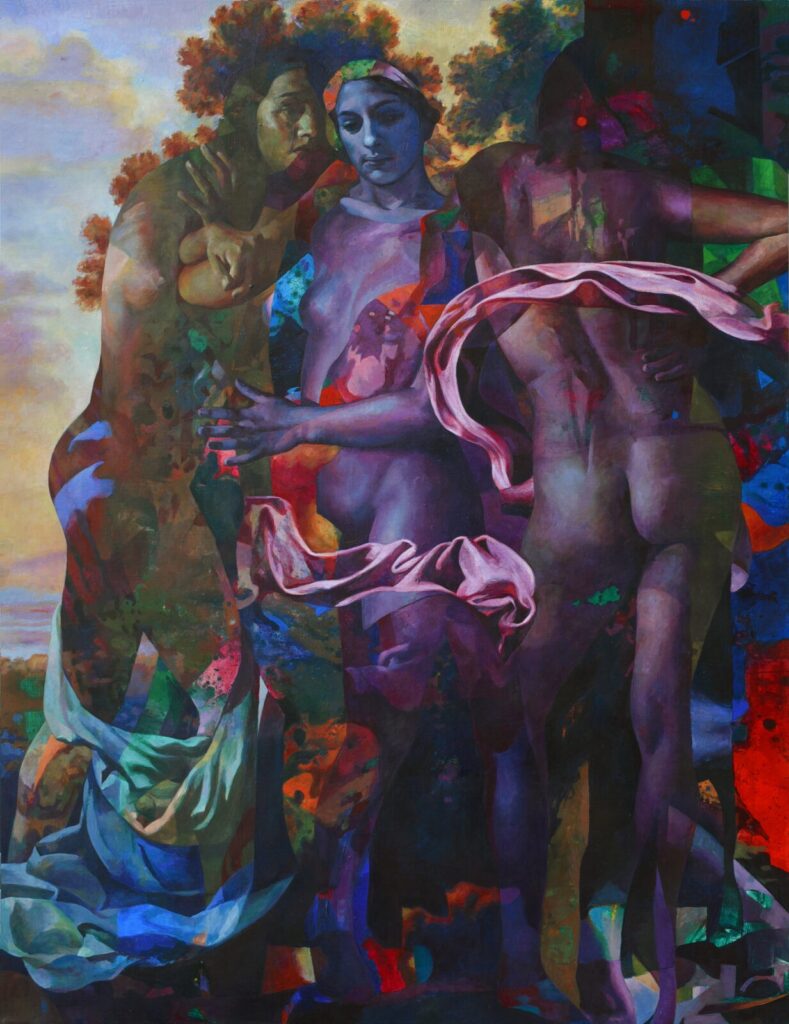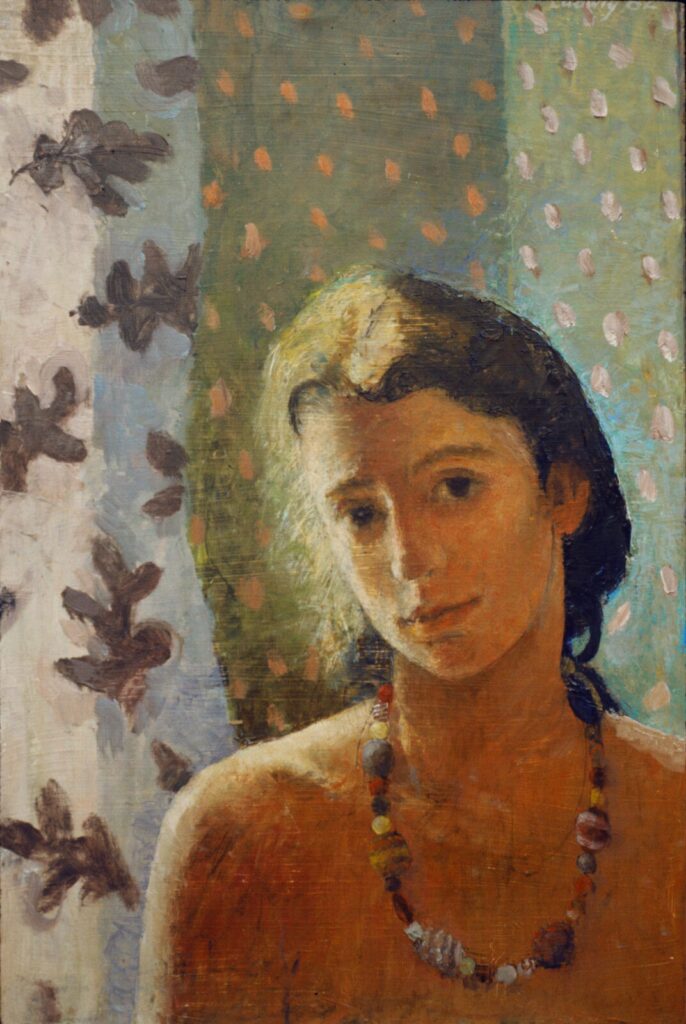Spread over three distinct locations, in three different municipalities, the retrospective of Daniel Ludwig’s practice—currently on view at Heike Pickett Galleries in both Versailles and Lexington and at the Georgetown College Art Galleries—presents a multidimensional perspective on the artist’s work over the last 35 years. Working primarily in painting, with a handful of works of sculpture, Ludwig has developed a clear aesthetic that combines elements of “the great art of Europe†with that of American vernacular painting; presented in this distributed fashion, this retrospective offers the viewer the opportunity to ruminate on specific elements of his practice in relation to the totality.Â
Heike Pickett Gallery & Sculpture Garden: Versailles
Nestled in a 1792 Federal House just off of Main street, Heike Pickett gallery is a small, independent gallery, open to the public on Friday and Saturday from 11 am to 4 pm or by appointment. Ludwig’s retrospective dominates the main gallery space, comprised of one large room with various alcoves that serve to further divide up the area. The age of the space, which exudes with the creak of every step along the hardwood, stands in stark contrast to the body of work on display, focusing exclusively on Ludwig’s work in the last several years.Â

From this exhibition, it becomes readily apparent how much Ludwig’s recent practice has been informed by a reimagining of canonical themes and motifs. For instance, one of the first images that you encounter is his work Graces, in which Ludwig presents three nude forms—only one of which is identifiably a woman—standing in interconnected poses, with free floating drapery dashed around and between their bodies, clearly alluding to the “three graces†of Greek Mythology and the myriad representations of these figures. Yet Ludwig subverts the conventional depiction of these figures by imbuing the work with a heavy use of arbitrary color, rendering two of the figures in a pale purple, as well as invoking the visual rhetoric of Surrealism by portraying the figures as somewhat translucent, revealing elements of the background landscape through the outlined form of their bodies.Â
This juxtaposition of many different painting traditions thus offers something altogether new, an illustration of the spectral presence that these historical depictions maintain within the current art world. They make clear to us as viewers the long legacy of art history that the artist must engage with in the name of innovation and provide one indication of the implications of that gesture. Other works in the space similarly engage with this long, Euro-centric art historical convention, making clear that as Ludwig looks back on his own art practice, he is both acutely aware of his personal history and his position as inheritor of the legacy of the European canon. This balancing between old and new, canonical and avant-garde is thus further affirmed by the relationship between the works and the architecture of the gallery.
Heike Pickett: Lexington
Whereas the Versailles gallery is an historic setting, the satellite space at CMW Architects — which is open Monday through Friday from 8 am to 4 pm — is a new, more industrial space. Located in the active offices of an architectural firm, the gallery space comprises of a long corridor, adorned with work on both sides, culminating with a large piece on the wall opposite the hallway at the far end. It is a unique sort of aesthetic experience, one in which the viewer may expect to have their experience interrupted by the sounds of typing or the faint smell of one of the employee’s perfume, all of which, undoubtedly will have some form of impact on their engagement with the work.Â

Proceeding through the space you get a greater sense of previous elements of Ludwig’s practice, revealing a different tradition that is prominent throughout his body of work from the middle of his career, specifically the rhetoric of American Realist painting. While Ludwig frequently cites the influence of seeing European Masterpieces during his time abroad in college, it is also abundantly clear in works like Bathers (1989)—which features three nude swimmers wading out in the ocean—the debt that Ludwig’s practice owes to the traditions of artists like Winslow Homer, John Singer Sargent, and, especially, Edward Hopper. Ludwig’s attention to the light and shadow, and the volume to which he gives his figures combined with a clear painterly quality of his brushwork and the high concentration of color all give the image this sense of a uniquely American experience within a singularly American landscape.
The particularly pastoral character of this work plays off the industrial nature of the space in a way that parallels the viewing experience in Versailles. Yet again the visual elements of the artwork diverge from the setting in which they are immediately found, allowing the viewer to experience the stark character of these scenes through the distinctions and contradictions that emerge in their presentation in this particular site. Â
Georgetown College Art Gallery:
Whereas the two previous sites have a clearer focus on a particular era of Ludwig’s practice, the exhibition at Georgetown college fits more in line with the traditional retrospective, a fitting gesture given the conventional nature of the gallery space itself. A well-lit white cube in the art building, walking into the Georgetown College Art Gallery, the viewer can expect to engage with the work in a more conventional and academic way. It is only fitting then that this space offers a more comprehensive survey of Ludwig’s practice, highlighting his early career, starting in the mid 1980s and extending to his most recent work.Â

In this space the viewer can see clearly how elements of European and American painting have always been present in Ludwig’s career, but that the extent to which he engages with one tradition over the other varies at any given moment. For instance, during the 1980s he made very clear references to German Expressionist traditions, such as the almost uncanny parallels between Paula Modersohn-Becker’s 1906 Self-Portrait and Ludwig’s Anne with a Necklace (1982) with regard to color, texture, and composition. At the same time, his more recent works, such as the painting Disfruta, maintain a clear reference to early 20th Century American art, evoking the social realist elements of works by artists like Thomas Hart Benton, Grant Wood, and Kentucky’s own Edward Melcarth through the clear depiction of industrial labor and American manufacturing in a manner reminiscent of WPA muralism. Â
The context of a university gallery thus affords a more academic and historical consideration for his work, preparing the viewer to engage with the full range of his practices through the site specific cues that prime the viewer to approach the art in a particular museological manner.Â
A Complete Retrospective
Taken as an aggregate, these three galleries do ultimately form a cohesive retrospective and offer the viewer a unique way to consider the life and career of a particular artist. Because it is impossible to see all three shows simultaneously or even within quick succession, the viewer is given a chance to pause and reflect between sites and to consider elements the various narratives surrounding Ludwig’s practice constructed in each space. It is, therefore, a unique viewing experience to construct an understanding of an artist’s work through deliberately stepping away and then back towards his work.
In addition to offering the viewer an opportunity to see concentrated pockets of work and take time to consider the show in each of the three spaces, the distribution of the exhibition across three different gallery sites also means that, more so than in other exhibitions, the experience of the viewer is heavily informed by the order in which they see it. Recognizing this to be the case, my experiences reflect only one possible permutation with which the audience can engage with this exhibition and should be noted as such. Moreover, what is unique about this model of a retrospective is that it presents multiple angles from which one can consider Ludwig’s work, effectively creating a more open curatorial experience through dispersed viewing. Â
 Reference Note: Fowler, Harriet, “Essay,†Daniel Ludwig Retrospective (Georgetown, KY: Georgetown College Art Galleries, 2018) 8.
___________________________________________________________
Daniel Ludwig: New Works 2016-2018
Heike Pickett Gallery & Sculpture Garden
110 Morgan Street, Versailles, KY 40383
Through June 8, 2018
Hours; Friday and Saturday, 11 am- 4pm and by appointment
(859) 233-1263 www.heikepickettgallery.com
_____________________________________________________________
Daniel Ludwig Retrospective: 35 Years of Artworks in Kentucky Collections
Ann WrightWilson Gallery at Georgetown College
Through May 25, 2018
Hours; Wednesday through Saturday, 12 am-4:30 pm and by appointment
(502) 863-8399
______________________________________________________________
Daniel Ludwig: Selected Paintings and Drawings
Heike Pickett Gallery at CMW
400 East Vine St. Lexington, KY (859)233-1263
Through June 8, 2018
Hours: Monday through Friday, 10 am.- 4 pm.
Gallery Hop with the Artist, Friday, May 18, 5- 8 pm




